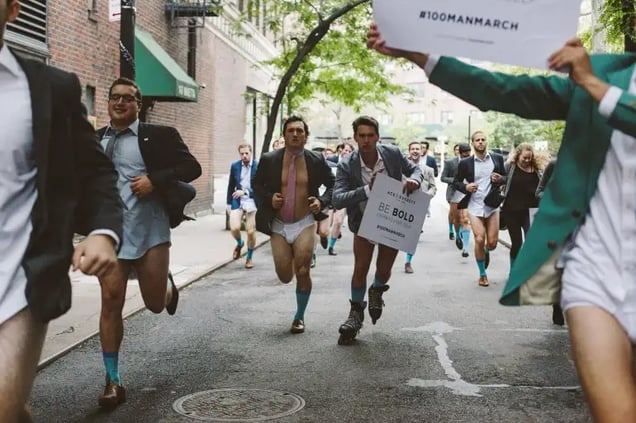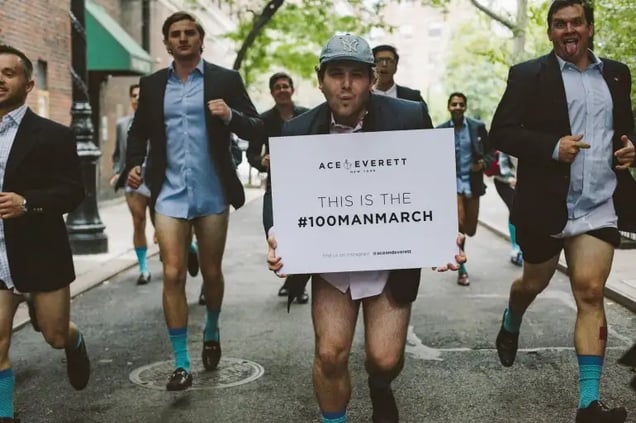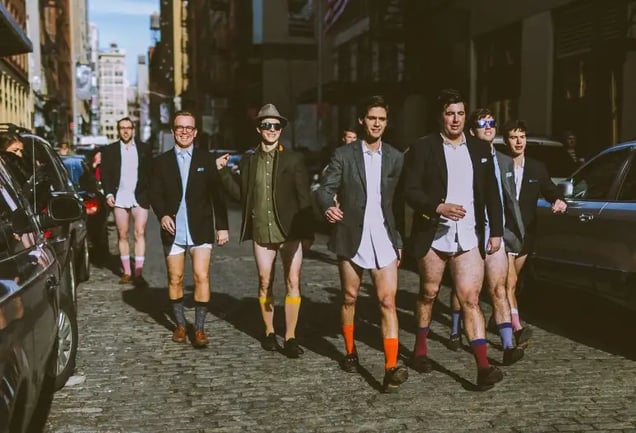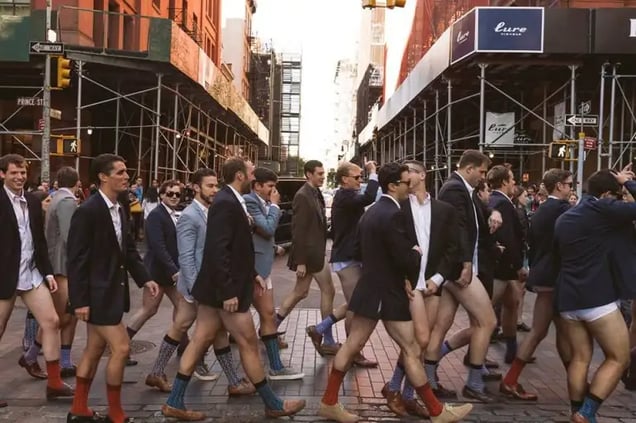At Ace & Everett, we make socks for the urban adventurer. To celebrate that adventure, we need our guys out of the office and into the streets. And as socks replace ties as the quintessential vehicle for male self expression, we want to make that personality more public.

That’s why we created the 100 Man March, a daylong event featuring men in blazers, button-downs, tighty whities, and Ace & Everett socks peacocking through Manhattan on a Saturday afternoon.
The event itself was born out of necessity. How do we share our product and celebrate our fans in a creative way? What event can we throw — what content can we generate — that has the viral potential to give our brand the millions of impressions it deserves?
It’s all about self-expression, brotherhood, and confidence. That’s what we believe in. That’s the message we want to spread. And this event helps us do that.
This year’s event


The 2016 version of the 100 Man March just concluded and it went great. We had an unreal turnout, solid weather, and a content strategy that worked.
But here’s the thing: Creating a viral event like this is hard. Really hard. In fact, it took us 3 years and a lot of trial and error to get here.
So, in order to provide a rubric for any other young, ambitious companies looking to do some young, ambitious things, we’ve decided to share the lessons we picked up along the way.
Year 1 (2014)

In 2014, twelve brave souls apprehensively met at our apartment in Brooklyn at 10 AM (far too early). Still groggy from the night before, it took a few beers and some heavy beats before the crowd stripped off their pants and jumped into tighties.
As noon approached, the unmarked white van pulled up and the boys piled in. We had a plan centered on visibility. Make a big enough scene in New York’s busiest areas and the shares, views, and virality would come. We hit Soho, Grand Central, and ended in Times Square.
But it didn’t work. The incredible images shot by the talented Humza Deas didn’t spread beyond our Instagram account, and the Internet passed over a few #100ManMarch hashtags despite our best efforts.
We learned that “if you build it they will come” does not apply to content driven events. Unless you’re streaking across the halftime show of the Superbowl, physical views are not enough to generate substantial buzz.
While we made a mark on the hundreds of people we encountered during the day, they had no way to tie the pantless gentlemen they saw to our brand.
Year 2 (2015)

As any startup worth their salt, we pivoted for year 2. We needed more people, more planning, and more content.
So for our second act, 50 guys showed up at 11 AM for bagels, mimosas, and marching (still too early). This time, we focused on capturing a bar crawl through video, which we believed was the best medium for showcasing the spirit of the day, and the form of content most likely to spread like wildfire beneath the Great Sept of Baelor.
Year 2’s greatest accomplishment was critical mass. Moving from 12 to 50 participants, the energy of the event was infectious. Armed with business cards featuring our website and Instagram handle, marchers were able to engage people on the street, explain why their pants were off (to showcase these socks, man!), and give people a clear way to follow our brand.
But once again, it didn’t work. One cannot underestimate the temporal nature of today’s content. Here today, gone tomorrow. We took 1 full week to publish our photos and share them with the marchers, and 3 weeks to share our advertorial video clips.
Why? We were obsessed with quality, and spent 2 full weeks creating an original score for the videos. By the time Ace & Everett’s digital assets were in the stratosphere, the momentum from the event had long since passed, leaving the tree to fall silently in an empty forest.

Time to reflect. While the event was growing, the audience wasn’t. Luckily, after two years we had a wealth of knowledge on what did, and more importantly, did not work.
Everything we’d learned going into 2016:
- The need to tie the event back to our brand
- The critical nature of quickly disseminating content (the faster you can edit and share, the better)
- People like to sleep in
We also decided it’d be beneficial to work with participants as catalysts for our third act. So we started planning Year 3’s content calendar — which we ended up following to a “T” — right away.
We’d march Saturday, send event photos to participants on Sunday recommending they share their favorite, and post our video to Facebook on Monday. Ideally, that’d set the stage for every water cooler conversation across New York City having tighties — and more importantly socks — on their mind.
The big takeaways
Make use of your evangelists, for they are your megaphones. Events like this are the most tangible opportunities you have to interact with your fans in an authentic, meaningful, and high touch manner. So make it count.
Bottom line, virality is a fickle beast. So set your expectations, and if you have a good idea, just freakin’ do it.
Potential is the key word. Like any entrepreneurial venture or marketing campaign, success is far from guaranteed. You need to embrace the uncertainty and ensure you do everything in your power to put yourself in a position to succeed.
